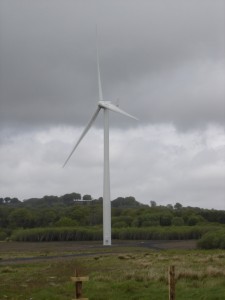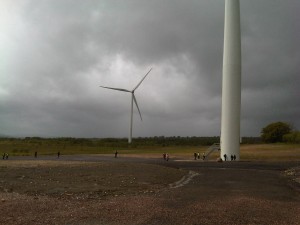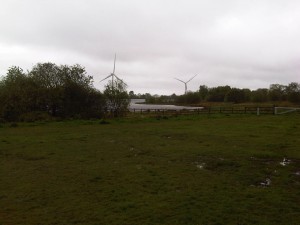Visit to Oakdale Wind farm 10th May 2014
Residents of Winterborne Whitechurch and other interested people were invited on a coach trip to visit the Oakdale Wind Farm near Caerphilly in Wales on the 10th May. Despite over 40 people expressing an interest in coming barely a dozen appeared on the grey morning at 8.30 for the trip to begin. At least the forecast was helpful. There would be little point in showing people a wind farm during a calm day when many of those with concerns are particularly worried about the noise of the turbines running at high load factor. We expected blustery showers – exactly the sort of weather to maximise the noise from the turbines.
After a long drive we finally arrived and the weather did not disappoint. Wind speeds at 7 feet above ground level were 8m/s with gusts into double figures. As we were 100m below the hub height, we could be pretty confident that the turbines were seeing the 13m/s or more needed to generate full 100% capacity factor peak output and the gusty conditions would be testing the gearboxes in such a way that they should be generating as much noise as they ever would. The coach was parked 400-500m from the turbines and the driver turned off the engine. We got out. What could we hear? Well, wind and that was about it. No deafening whooshing sound or explosive thumps just wind noise. The ground did not shake with scary infrasound vibrations and no one swooned with nausea or dizziness. We walked closer and by 300m from the turbines we could just about pick out a slight rythmic undertone to the wind noise but you had to know what you were listening to to know it was there. A skylark took off from the grassland surrounding the turbines and started to sing. It was clearly audible and a pleasure to see even if it failed to ascend much in the high wind.
We reached the turbine base and started to discuss what we could see. No one was shouting and what noise there was, was still as much due to the natural sound of the wind as the turbines. The heavens opened and we all made a run for it back to the coach well soaked for our pains.
So 4 hours in the coach to get there and a damp 4 hours in prospect to get back after 15 minutes on site. What did we learn? Well, I think it was fair to say that many were surprised as to just how quiet the turbines were including myself. I have visited a few wind farms but this was my windiest trip to date and the quietness exceeded even my hopes. Many expressed an admiration of the engineering and architectural qualities of the turbines. Noone seemed to think they were an eyesore in themselves. So everyone was now keen to have wind turbines at Winterborne Whitechurch? Well no. There were two main worries. The most important can be summed up as “Why do they need to be so big?” Some people said they appreciated all the reasons why we needed renewable energy in general and wouldn’t object to hosting wind turbines if only they were say half the size. So why can’t we build them half the size? A suspicion seemed to be lurking beneath the surface of the conversation that this was just about big business maximizing its profits. Unfortunately it is really about the inescapable laws of physics. If you halve the size of a turbine you don’t just halve its output and you certainly don’t halve the costs to build and run it. Because the amount of wind pushing on the turbine depends on the area of the circle traced out by the blades halving the size will quarter the output if this were the only relevant consideration. Unfortunately we are far from finished.
As you go further up from the ground the wind speed (velocity V) increases. This is called wind shear. The amount of power in the wind that the turbine can use is dependent not on the speed of the wind or even the square of the speed of the wind. It is dependent of the cube of the speed of the wind because the energy of any sample of air is equal to ½ mV2 as many might remember from school Physics and the amount of air passing the turbine is dependent on the speed of the air passing so these considerations combined makes the Power dependent on the cube of the speed. Once the mast data from Blandford Hill is available we can work out an equation to model the precise rate at which wind speed varies with height but just for the sake of argument let’s assume that a turbine half the height of those suggested still sees wind speeds three quarters of the speed seen by the full size version. This means that the power available to the small turbine is (0.75)3 times the power of the big one or 0.422 times its value. Therefore overall we can expect the output of a turbine half the size of the one suggested to be about 10.5% of that from the large one or put it another way we will need 10 times as many turbines to produce the same results. Now we know for sure that building and running a half sized turbine (with all the additional costs of cabling, transformers etc) will cost at least half as much as running the big one and will probably cost much more than that but assuming we lose no net cost benefits of scale this still means that the electricity from the small turbine could cost 5 times that from the big one. I suggested to some of my fellow visitors that this might be the case and some seemed sceptical and others said they wouldn’t mind paying more for their electricity if it meant we could make do with smaller turbines. But five times the cost? And the countryside covered in 10 times the number of turbines? It doesn’t make sense to me. I really don’t find the prospect of being able to see say 4-6 large turbines from my house unacceptable and would welcome them but 40-60? Even I would join the ranks of the NIMBYs at that. If there is a big business conspiracy at work in the energy debate today it is the big multinational oil and gas firms desperate to squeeze the last drops of profit out of their diminishing resources even if it means bankrupting our fuel impoverished economy and wrecking the environment in the process not the relatively tiny firms like REG or Good Energy trying to introduce new sustainable technology and challenge the effective cartel of the big energy companies.
The other objection was that it would change the Dorset countryside. Unfortunately the Dorset Countryside has changed, is changing and will continue to change regardless of whether or not we have wind turbines. It is only a few years since our countryside started turning bright yellow every late spring with oil seed rape. This changed the look of the countryside and caused real health worries for allergy sufferers. But oil seed rape seems to be an indispensable part of our modern food economy and also our emerging biofuel economy so we put up with it and, now we are used to it, hardly notice it except for those like myself who curse when we see the bright flash of yellow from our car because we know it will be rapidly followed by a tightening of the chest and a spluttering coughing session (I recognise that my degree of suffering from hay fever is trivial compared to many for whom it is much more of an issue). I tried to point out that even our beloved hedgerows are recent additions to the countryside in many areas and were understandably greeted with loathing by many who lived there because they destroyed the quasi democratic system of three field agriculture and handed the best land to the richest and most powerful land owners. Many suffered real poverty because of them. I was derided for trying to equate a huge industrial object like a wind turbine with lovely natural things like hedgerows. However I say there are parallels. Hedged fields are not natural – acres of monoculture surrounded by bushes forced to lie flat and trimmed to a standardized height? They provide protection for the displaced and threatened nature that colonises them and wind turbines are part of what we must do to protect threatened nature from the effects of climate change and by so doing protect the species we rely on for our food, our natural building materials and the biofuel to cheer our winter grate.
Finally one of our group mentioned the fact that the wind turbines are a very similar height to Salisbury Cathedral although I think the person was trying to wind me up a bit at that point. This fact is a recurrent favourite of the anti-wind turbine protestors and was mentioned by just about every one of that opinion at the planning meeting I attended a few months ago regarding Silton. I fail to see the relevance of this information as a point against wind turbines unless there is some suggestion that by building something the same height as the cathedral we are committing sacrilege and risk the Wrath of God. Now I know that Dorset can be a bit behind the times but surely this is too medieval even for here. On the other hand what this fact says to me is that for nearly a thousand years we have been prepared to build structures in the Dorset landscape of this size if it is over a matter that is of sufficient importance. I truly believe that Climate Change and our need for sustainable clean energy are two of the most important issues we face as we enter the 21st Century and that although they will bring changes, wind turbines will not ruin the countryside, nature or people’s lives but they will give us a fighting chance of doing something about these important issues whilst there is still time.
If you have read this you might be interested in this item on the Good Energy Blog – someone`s firsthand experience of living next to a wind farm – http://www.goodenergy.co.uk/blog/living-next-to-a-wind-farm-a-personal-experience




Thanks Erik for sharing your experience. It’s good to know it was so positive. I am very interested to find out more about how people experience turbines, incl. whether there are individual differences between people, and also design factors that are crucial in avoiding problems with noise / subsonic vibration etc. Off to Delabole on Saturday to learn more for myself (I live near the proposed Slyers Lane turbines).
Hi Sally. I hope you enjoy Delabole. Have you seen the piece from the gentleman living near Delabole? The link is at the bottom of my piece. If you live in Tolpuddle then I think it is worth pointing out that any noise or subsonic vibration from the wind farm at Slyers Lane will be dwarfed by those from the road between the farm and the village. Infrasound isn’t unique to wind turbines. It comes from traffic and household appliances. The degree to which people are annoyed by anything is heavily influenced by their mental attitude to the thing. I honestly do not believe there is a plausible scientific reason why vibrations from wind farms pose any significant medical threat to people except through negative suggestion and placebo caused by the scare stories put about by opponents of renewable energy.
Hi Sally again,
Sorry for the confusion. Of course I got Slyers Lane mixed up with Tolpuddle. However I have just checked the map for Slyers Lane and as it is next to the A35 my comments about infrasound and noise from road traffic still apply. Although road noise may be annoying neither the vibrations from the road nor any that might come from the wind turbines (and they will be far less if you are equidistant from the road and the farm) are going to harm you but you are at risk from those who would frighten you with false claims of health risks. The placebo effect is very powerful whether used for good or bad. Being vulnerable to it isn’t a matter of low intelligence or anything negative about the person. In fact it perhaps suggests a good imagination but whether the cause is the imagination or not the effects can be very real which is why I get so angry about those who go around frightening people about wind turbines just because they know that saying that they just don’t like the look of them in their neighbourhood isn’t such a good argument.